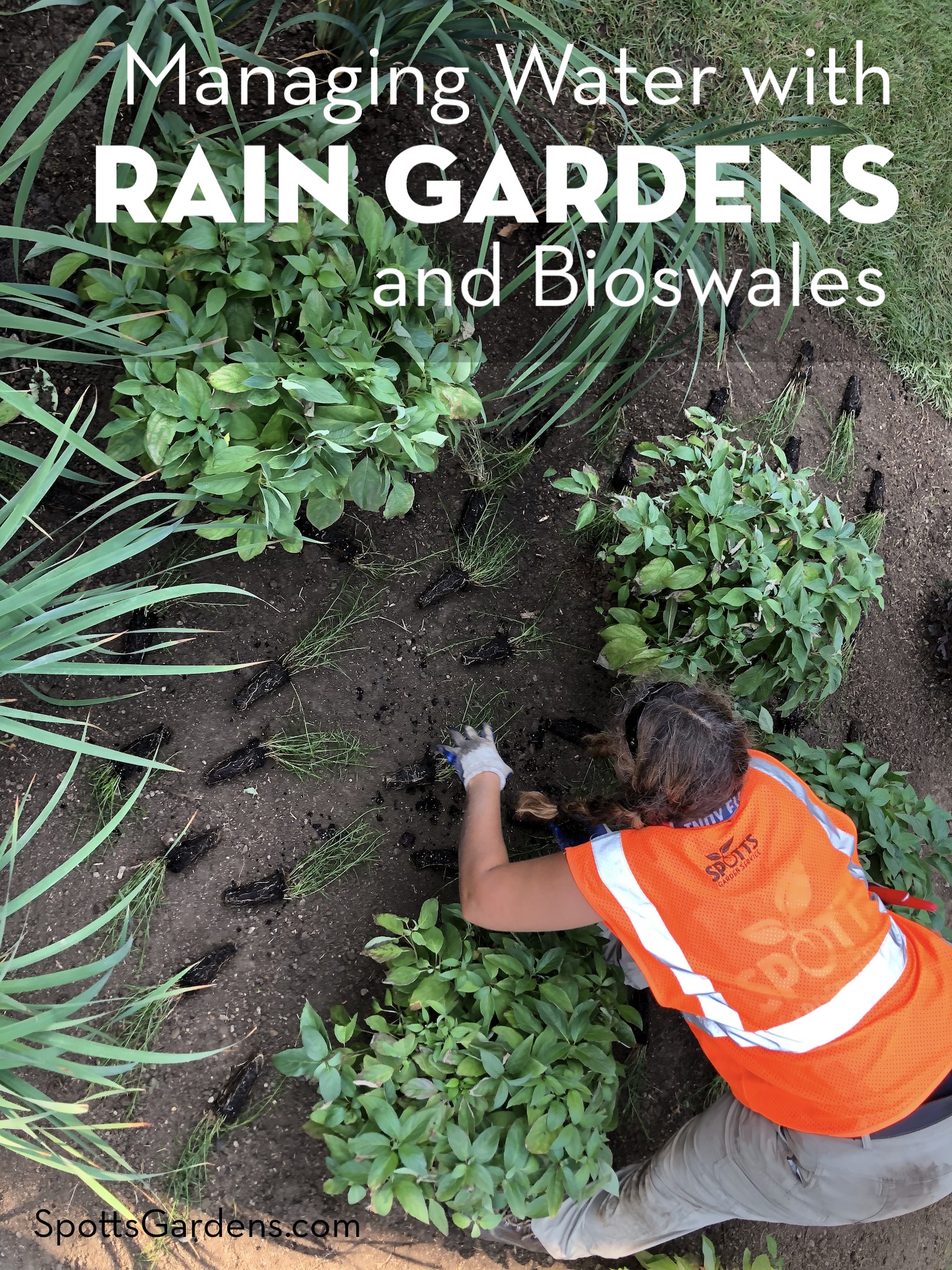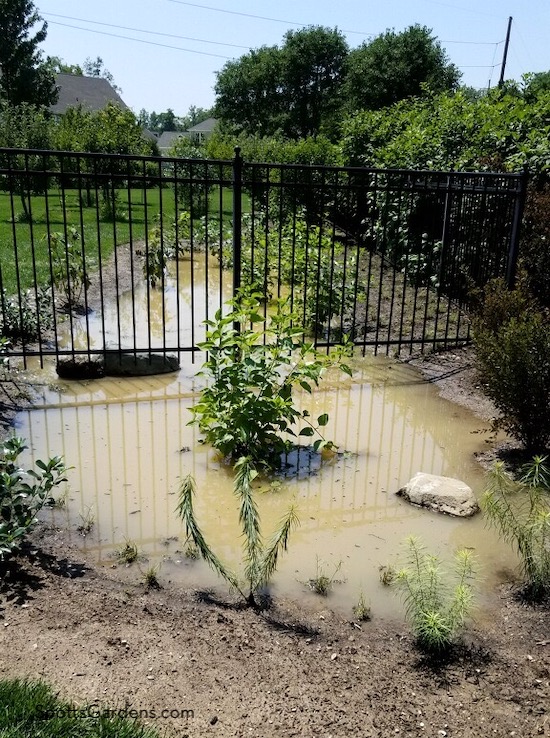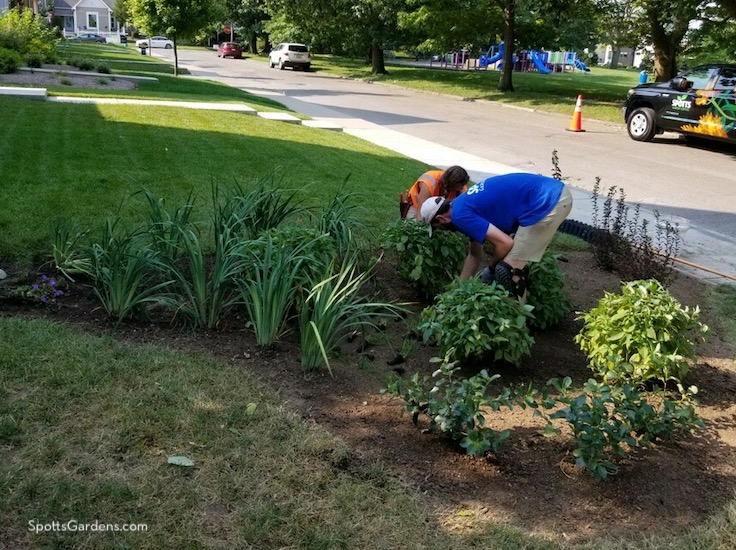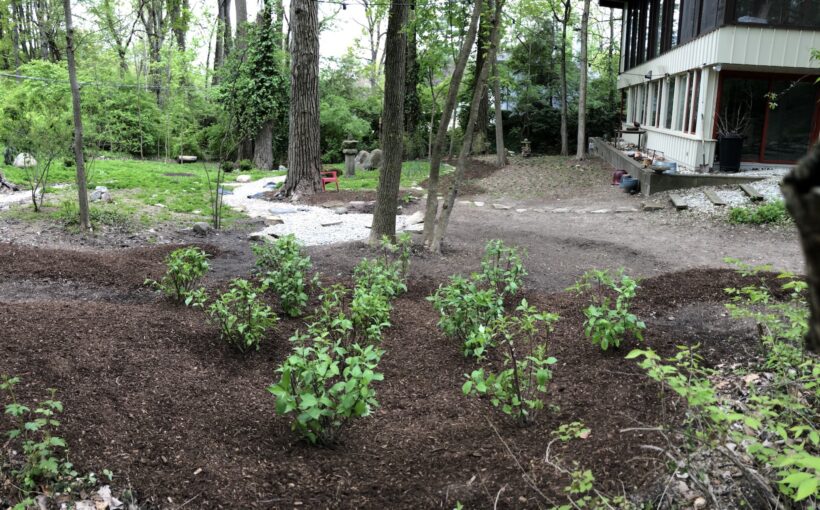If you read our post on rainscaping, you already know our rainwater mantra is “Slow it down. Spread it out. Soak it in.” We want to return as much rainwater as possible to the ground where it falls, instead of allowing it to run off into a storm sewer. Our go-to tools for the “soak it in” portion of the agenda are the rain garden and its skinny cousin, the vegetated bioswale.
Rain Gardens versus Bioswales
A shallow depression about 6″ at its deepest, the rain garden is planted with tough, deep-rooted plants that improve the soil’s ability to soak up water. Runoff from elsewhere in the garden flows into the rain garden, which temporarily holds and filters the water as it infiltrates into the soil.
A vegetated bioswale is essentially a narrow version of a rain garden. The main difference is that the bioswale moves water to somewhere else in the garden, while also allowing some (but not all) of it to infiltrate. A rain garden is specifically meant to increase infiltration.
Bioswales are often used to convey water to a rain garden. In properties with no rain garden, bioswales can direct water into an existing drainage or storm system.

Benefits of Rain Gardens
Whether your style is formal or naturalistic, we can design a rain garden that fits your tastes and your site. They’re adaptable to sites from sun to shade, too.
Because rain gardens hold rainwater until it can soak back into the soil, they reduce storm runoff and the pollutants it carries into our waterways. Rain gardens also serve as filters, removing contaminants from the water before it returns to the ground.
Rain gardens planted with native plants are havens of biodiversity. They’re bird and pollinator magnets too.
Creating a Rain Garden
We build “native soil” rain gardens, which means we work with the soil already in place instead of bringing in an engineered soil mix. After digging out the basin, we use tillers to break up soil and incorporate compost. The compost improves the ability of the soil to take up and hold water.
Water enters the rain garden through surface channels, by sheeting over the sides, or via a pop-up emitters from downspouts or sump pumps. Using stones at the entry points forces water to slow down as it enters.
Rain gardens can stand alone or be constructed in chains, with overflow from one rain garden flowing into the next. In a really big rain event, the garden will hold the first flush of rain (which is where the sediment and pollutants are), while allowing cleaner water to trickle out a small overflow channel on the downhill side of the garden.
Water in a rain garden usually soaks into the soil within 24 hours of a rain event. Because rain gardens dry out quickly, they don’t harbor mosquitoes the way boggy spots can.
Rain gardens aren’t suitable for every site. They should be at least 10′ away from foundations and 5′ away from property lines. They’re best constructed on gentle or moderate (not steep) slopes in areas with decent drainage. Fortunately, other rainscaping options can work even when a rain garden isn’t the right choice.

Even before we finished planting, this rain garden basin began to collect rainwater.
Planting a Rain Garden
We plant rain gardens primarily with deep-rooted native plants. The basin requires plants that can handle periodic inundation and dry spells. We have a wider range of plant choices for the slopes, which are rarely if ever under water. Check out our favorite rain garden plants here.
We use a mix of plant types, including shrubs, perennials, grasses, and sedges. To minimize maintenance, we often underplant the shrubs with low-growing sedges, which grow into a weed-suppressing ground cover. As the plants fill in and increase their root mass, they can take up more water, making the rain garden more efficient over time.

Even a small rain garden like this one can return a lot of runoff back into the soil.
Caring for Rain Gardens
Rain gardens are relatively simple to take care of. The first couple of years require regular weeding, and you should check for and remove sediment a few times a year. Because rain gardens are more efficient with lots of biomass, we don’t want to thin shrubs or cut back vegetation too much.
Our rain garden maintenance schedule for central Indiana is:
Early spring (March): Cut back grasses and sedges. Prune shrubs if necessary. Check for and remove sediment.
Spring (April): When new growth is about 4″ to 6″ tall, cut back any tattered or dead perennial growth taller than that. Unlike in most gardens, don’t cut back to the ground; just take the top down to about 4″. Weed. Check for and remove sediment.
Late spring (May): Cut back grasses again if necessary (after any ground-nesting birds have flown the nest). Weed. Check for and remove sediment.
Fall (October or November): Remove seed heads of any plant likely to self-sow dramatically. Weed. Check for and remove sediment.
Ready for a Rain Garden?
We’ll create one perfect for you! Contact us for a free estimate.
